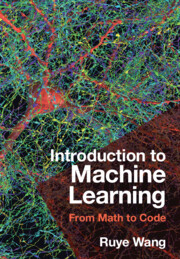Refine search
Actions for selected content:
180 results

Introduction to Machine Learning
- From Math to Code
- Coming soon
-
- Expected online publication date:
- January 2026
- Print publication:
- 18 December 2025
-
- Textbook
- Export citation
Artificial intelligence in breast cancer diagnosis: A systematic literature review
-
- Journal:
- Cambridge Prisms: Precision Medicine / Volume 3 / 2025
- Published online by Cambridge University Press:
- 21 November 2025, e7
-
- Article
-
- You have access
- Open access
- HTML
- Export citation
Do stable neural networks exist for classification problems? – A new view on stability in AI
- Part of
-
- Journal:
- European Journal of Applied Mathematics , First View
- Published online by Cambridge University Press:
- 20 November 2025, pp. 1-21
-
- Article
-
- You have access
- Open access
- HTML
- Export citation
Instability in deep learning – when algorithms cannot compute uncertainty quantifications for neural networks
- Part of
-
- Journal:
- European Journal of Applied Mathematics , First View
- Published online by Cambridge University Press:
- 20 November 2025, pp. 1-23
-
- Article
-
- You have access
- Open access
- HTML
- Export citation

Mathematical Methods in Data Science
- Bridging Theory and Applications with Python
-
- Published online:
- 04 November 2025
- Print publication:
- 30 October 2025
-
- Textbook
- Export citation
8 - Neural Networks, Backpropagation, and Stochastic Gradient Descent
-
- Book:
- Mathematical Methods in Data Science
- Published online:
- 04 November 2025
- Print publication:
- 30 October 2025, pp 494-559
-
- Chapter
- Export citation
1 - What Is AI?
-
- Book:
- Artificial Intelligence in Schools
- Print publication:
- 30 October 2025, pp 4-23
-
- Chapter
- Export citation

Deep Learning in Quantitative Trading
-
- Published online:
- 03 October 2025
- Print publication:
- 30 October 2025
-
- Element
- Export citation
Neuromodulation and neural networks in psychiatric disorders: current status and emerging prospects
-
- Journal:
- Psychological Medicine / Volume 55 / 2025
- Published online by Cambridge University Press:
- 26 September 2025, e281
-
- Article
-
- You have access
- Open access
- HTML
- Export citation
6 - Statistical Learning
- from Part III - Advanced Concepts
-
- Book:
- Statistics for Chemical Engineers
- Published online:
- 12 December 2025
- Print publication:
- 25 September 2025, pp 289-384
-
- Chapter
- Export citation
1 - An Overview of Artificial Intelligence
- from Part I - Background on AI and IP
-
- Book:
- AI versus IP
- Published online:
- 09 August 2025
- Print publication:
- 28 August 2025, pp 9-30
-
- Chapter
- Export citation
Measuring Descriptive Representation at Scale: Methods for Predicting the Race and Ethnicity of Public Officials
-
- Journal:
- British Journal of Political Science / Volume 55 / 2025
- Published online by Cambridge University Press:
- 18 August 2025, e110
-
- Article
-
- You have access
- Open access
- HTML
- Export citation
How Linguistics Learned to Stop Worrying and Love the Language Models
-
- Journal:
- Behavioral and Brain Sciences / Accepted manuscript
- Published online by Cambridge University Press:
- 24 July 2025, pp. 1-98
-
- Article
-
- You have access
- Export citation
9 - Neural networks and deep learning
-
- Book:
- Financial Data Science
- Published online:
- 17 December 2025
- Print publication:
- 17 July 2025, pp 215-244
-
- Chapter
- Export citation
12 - Regression and Classification
-
- Book:
- Probability and Statistics for Data Science
- Published online:
- 19 June 2025
- Print publication:
- 03 July 2025, pp 495-598
-
- Chapter
- Export citation
Machine learning as an enabler for design automation in engineering-to-order industry
-
- Article
-
- You have access
- Open access
- HTML
- Export citation
Development of a robust deep learning model for weed classification across diverse bermudagrass turfgrass regimes in China and the United States
-
- Journal:
- Weed Science / Volume 73 / Issue 1 / 2025
- Published online by Cambridge University Press:
- 25 June 2025, e50
-
- Article
-
- You have access
- Open access
- HTML
- Export citation
7 - Divide and Concur
-
- Book:
- Solving Problems with Projections
- Published online:
- 05 June 2025
- Print publication:
- 19 June 2025, pp 262-354
-
- Chapter
- Export citation
Discovering effective policies for land-use planning with neuroevolution
- Part of
-
- Journal:
- Environmental Data Science / Volume 4 / 2025
- Published online by Cambridge University Press:
- 19 May 2025, e30
-
- Article
-
- You have access
- Open access
- HTML
- Export citation
ARTIFICIAL INTELLIGENCE INFORMED SIMULATION OF DISSOLVED INORGANIC NITROGEN FROM UNGAUGED CATCHMENTS TO THE GREAT BARRIER REEF
- Part of
-
- Journal:
- Bulletin of the Australian Mathematical Society / Volume 112 / Issue 1 / August 2025
- Published online by Cambridge University Press:
- 16 May 2025, pp. 216-219
- Print publication:
- August 2025
-
- Article
-
- You have access
- HTML
- Export citation































